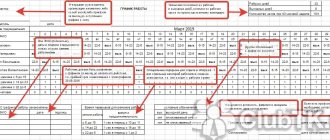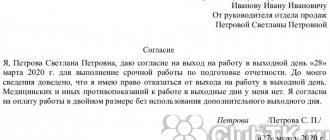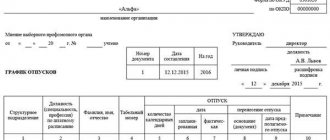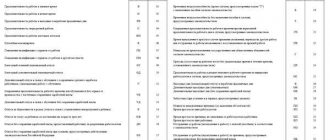Description of basic concepts
A shift work schedule is an order in which some workers are replaced by others to perform the same types of work. Moreover, each citizen works on a certain day of the week.
For example, there are two employees, and the schedule is two days after two. For one employee you can set the following as workers:
- For one week, Monday, Tuesday, Friday and Saturday.
- For the second week, Tuesday and Wednesday, Saturday, Sunday.
Such schedules are relevant if the production process at the enterprise does not tolerate long interruptions. Article 103 of the Labor Code of the Russian Federation controls this mode of operation.
It is permissible to introduce two, three, or four shifts. When using this type of schedule, workers are divided into several groups at once. Each of them performs work on certain days and hours.
What does shift work mean?
The rules for establishing a shift work schedule at an enterprise are prescribed in Article 103 of the Labor Code of the Russian Federation. This schedule implies the organization of work with:
- the duration of the production process is more than the normal duration of the working day;
- organizing more appropriate use of machinery, equipment, and production space;
- the need to increase production volumes;
- organizing round-the-clock operation of trade or public service facilities;
- other production factors.
Work can be organized in two, three or four shifts. At the same time, working for two shifts in a row is prohibited.
Payment for holidays during a shift work schedule
Article 153 of the Labor Code states that holiday work shifts require a minimum of double pay. The calculation is carried out taking into account not the entire shift, but the hours that were actually spent performing duties at that moment. There are often shifts that move from one day to the next.
One scheme is used with standard salaries. Then you first need to calculate the average cost of labor for one day. Then the result is multiplied by 2.
Remuneration for shift work: features
As a rule, a company with a shift schedule establishes a summarized recording of working hours. Its peculiarity is that labor standards are determined within the accounting period: month, quarter or year. And the salary is calculated based on the tariff rate determined for this period.
Pay per shift is also calculated based on the hourly wage rate multiplied by the number of hours in the shift.
Example.
Semenov S.S. The salary is set at 40,000 rubles. The company has established a summarized recording of working hours. In March, all scheduled hours were worked (159 hours). The accounting period is 1 year (according to the production calendar, this is 1970 hours).
Salaries in different months may differ due to the different number of working hours in them.
The use of summarized accounting for shift workers is not mandatory. The organization has the right to establish another form of payroll, for example, time-based, based on salary. Payment for a shift work schedule with salary will be calculated in the usual manner. That is, if the working hours are fully worked according to the schedule, the employee will be paid the salary in full:
Examples of calculations using the two-by-two scheme
Let's look at one example that helps you understand how to pay for holidays, even if they are only part of the schedule.
There is a schedule according to which a subordinate works 12 hours for 16 days. Of the total, two holidays stand out. The rate for one hour of work is 150 rubles.
Two days with 12 hours of work are paid using the double tariff. We multiply 150 by 24 and multiply by 2. The result is 7200.
The rest have 14 days of 12 hours - standard single size. We simply multiply 14, 12 and 150. We get 25,200 rubles.
In total for May, the employee receives a salary consisting of two figures received earlier. The entire amount is issued in person minus income tax at a rate of 13%.
For information on calculating wages during a shift schedule, watch this video:
Concept
Shift work refers to a work schedule in which people work on different days of the week. Some workers are replaced by others to perform the same activities.
Suppose, with a two-by-two schedule, an employee can work:
- in one week: Monday, Tuesday, Friday, Saturday;
- on the 2nd: Tuesday, Wednesday, Saturday, Sunday.
It is advisable to introduce such schedules if the production process requires constant operation of the enterprise. Shift work is provided for in Art. 103 Labor Code of the Russian Federation.
People can work two, three or four shifts. Such a schedule helps to divide workers into certain groups, each of which performs work on certain days and times.
It is important that a person does not work two shifts in a row; this is prohibited by Part 5 of Article 103 of the Labor Code of the Russian Federation.
Rules for increasing the cost of work
Such increases are permissible for employees representing one of the following categories:
- When using the piecework payment option. That is, when the determining factor is the actual quantity of services and goods produced.
- With daily or hourly rates.
- Workers who receive a standard salary.
If an enterprise’s internal documents indicate a smaller amount of payment for holidays than usual, this is a direct violation of current legal requirements. Such decisions are easy to appeal when going to court.
In this case, an employee can choose to receive additional rest if he not only works on weekends and holidays, but also exceeds the established standards for labor results.
How is a holiday paid for shift work?
Payment for holidays is regulated by labor legislation. According to Art. 153 of the Labor Code of the Russian Federation, work on a state holiday is paid at least double the amount
According to Art. 112 of the Labor Code of the Russian Federation, holidays in the Russian Federation:
- January 1–6, 8 — New Year holidays;
- January 7—Christmas Day;
- February 23 - Defender of the Fatherland Day;
- March 8—International Women's Day;
- May 1 - Spring and Labor Day;
- May 9 - Victory Day;
- June 12—Russia Day;
- November 4 is National Unity Day.
But often holidays fall on Saturday - Sunday, so officials approve plans to move holidays to nearby dates (Part 5 of Article 112 of the Labor Code of the Russian Federation). The transfer schedule is approved annually. You can find out how we are resting in 2020 from our production calendar by clicking on the link.
Attention! The President of the Russian Federation declared the period from 03/30/2020 to 05/11/2020 non-working days due to the spread of coronavirus infection. These days do not include weekends and holidays and are paid at the usual non-increased rate.
ConsultantPlus experts have prepared a review of “Non-working weeks: what to do as a personnel officer and accountant.” If you have access to K+, proceed to this material. If you don’t have access, get a trial demo access to the system for free.
Most workers are accustomed to the combination of “work on holidays - double pay.” It means that:
- piece workers will receive payment at no less than double piece rates;
- employees whose work is paid at daily or hourly tariff rates will receive at least double the daily/hourly tariff rate;
- Salaried employees will receive no less than a single daily or hourly rate for work within the monthly working time standard, and for work in excess of the monthly standard - no less than double the daily or hourly rate/part of the salary.
In this case, payment in an increased amount is made specifically for hours actually worked on a weekend or non-working holiday. If part of the working day (shift) falls on a weekend or non-working holiday, the increased rate is paid not for the whole day, but for the hours actually worked on the weekend or non-working holiday (from 0 hours to 24 hours).
This approach really does not contradict the law, but for the purpose of remuneration it is not the only option.
At the request of an employee who worked on a non-working holiday, he may be given another day of rest. Then work on a non-working holiday is paid at the usual (single) rate, but the day of rest is not paid.
If an employee works on a shift schedule and his shift falls on a non-working holiday, such work is also paid at an increased rate. Shift workers have a nuance in paying for holidays: if the work was carried out within the employee’s normal working hours in the corresponding period, then it will not be possible to replace this day with the employee’s consent with single pay and time off (clause 5 of the recommendation of the Federal Service for Labor and Employment dated 06/02/2014 ). But if such work on a holiday is performed in excess of normal working hours, the employee chooses himself: either double pay, or single pay plus time off.
When double pay is replaced by rest
In some situations, subordinates have the right to demand time off instead of double remuneration for holidays worked. The decision in each case is individual and depends on how much time has actually been worked up to the present moment.
Such demands cannot be made only by those who usually work overtime. The same applies to the use of a shift schedule.
How to pay for “holiday” work
The rules are established in Part 1 of Art. 153 of the Labor Code of the Russian Federation (general provision - no less than double):
- for piece workers - no less than double piece rates;
- for employees receiving earnings at daily and hourly rates, the rate is also doubled;
- Accordingly, salaried employees are entitled to the necessary additional payment. Its size depends on whether the work was performed within or in excess of normal working hours (single daily or hourly rate and double).
Increasing the cost of working hours on holidays
Labor legislation, namely Article 153 of the Labor Code of the Russian Federation, provides for increased wages for work on the above holidays. This is possible for the following types of workers:
- Workers whose wages depend on the amount of work done, that is, piece workers;
- Employees of organizations whose wages are calculated based on daily or hourly tariff rates;
- Working persons receiving a salary.
As a rule, for all of the above persons, the cost of work on a holiday is expected to be doubled relative to ordinary days.
Important ! However, internal local acts, labor or collective agreements can significantly affect wages on holidays, since the employer has the right to prescribe its own conditions in them. But do not despair if the regulatory documents of your enterprise indicate smaller amounts of payment for holidays, since this is a direct violation of labor legislation, which can be challenged in court.
In addition, employees who work on holidays and at the same time exceed the monthly labor standard, that is, working overtime, have the right to choose rest instead of double pay for such a day.
Important ! For workers during a federal or regional holiday, within the established norm, the only solution is provided - the calculation of wages for such a day in double amount.












